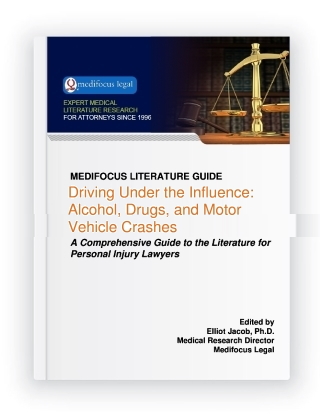Driving Under the InfluenceA Comprehensive Guide to the Literature for Personal Injury Lawyers
Publisher: Medifocus Legal
Publication Date: December 29, 2022
Number of Pages: 138
A Comprehensive Guide to the Literature for Personal Injury Lawyers
Publisher: Medifocus LegalPublication Date: December 29, 2022
Number of Pages: 138
The level of alcohol in a person's body, known as the blood alcohol concentration (BAC) can be measured with either a device called a breathalyzer or by a blood test. Research shows an exponential increase of the relative risk for a crash with a linear increase in BAC. In the United States, it's illegal to drive or otherwise operate a motor vehicle with a BAC of 0.08g/dL or higher. Even lower levels of BAC, however, can affect driving ability. For example, the typical effects of a BAC of 0.05g/dL may include exaggerated behavior, loss of small-muscle control (e.g., difficulty focusing the eyes), impaired judgment, and decreased alertness.
Like alcohol, a variety of other drugs have been found to impair a person's ability to safely operate a motor vehicle. For example, recreational drugs such as marijuana and hashish can impair the psychomotor skills necessary for safe driving. In addition, prescription medications including opioids, benzodiazepines, antiepileptics, and antidepressants often cause side effects such as excessive drowsiness that can result in drug-impaired driving.
Because the consequences of a DUI conviction are usually severe and may include multi-year jail terms, stiff financial penalties, and suspension or permanent revocation of a person's driver's license, individuals facing DUI charges typically retain the services of an attorney in hope of obtaining the best possible outcome.
Litigating drunk driving cases not only requires expertise in this specialized area of the law, but also a fundamental knowledge of the physiological, toxicological, and cognitive effects of alcohol and other drugs that can impair safely operating a motor vehicle. That's why we produced the MediFocus Literature Guide to Driving Under the Influence. This valuable Guide includes over 180 journal article references published over the past decade in peer-reviewed scientific and medical journals and also includes hyperlinks to the Abstracts of each article. The Guide will be a valuable addition to the library of attorneys who specialize in litigating DUI cases.
 |
- A comprehensive bibliography of 223 journal article references indexed in MEDLINE published in well respected medical and scientific journals.
- Online access to the abstracts (summaries) of the articles.
- Online access to the free full-text version of 28 articles.
- Links to full-text sources of other articles that are available for purchase directly from individual journal publishers.
- A unique "Author Directory" consisting of the names and institutional affiliations of experts who have published and have specialized knowledge about Driving Under the Influence. The "Author Directory" is a valuable resource for quickly identifying and locating experts for case reviews, opinions, and testimony.
Select examples of topics that are covered by the articles referenced in this Guidebook include:
- Pupil function as an indicator of being under the influence of central nervous system-acting substances from a traffic-medicine perspective
- A Judicial Perspective on Expert Testimony in Marijuana Driving Cases.
- Delays in DUI blood testing: Impact on cannabis DUI assessments.
- Detection of illicit drugs in oral fluid from drivers as biomarker for drugs in blood.
- Current defense strategies in some contested drink-drive prosecutions.
- Legal consequences for alcohol-impaired drivers injured in motor vehicle collisions: A systematic review.
- The accuracy of handheld pre-arrest breath test instruments as a predictor of the evidentialbreath alcohol test results.
- The combined effects of alcohol and cannabis on driving: Impact on crash risk.
- Comparison of breath-alcohol screening test results with venous blood alcohol concentration in suspected drunken drivers.
- Variability in the blood/breath alcohol ratio and implications for evidentiary purposes.
- An examination of the validity of the standardized field sobriety test in detecting drug impairment using data from the Drug Evaluation and Classification program.
- Accuracy and reliability of breath alcohol testing by handheld electrochemical analysers.
- The Standardized Field Sobriety Tests: a review of scientific and legal issues.
- Police custody following driving under the influence of cannabis: a prospective study.
- Ethanol elimination rates at low concentrations based on two consecutive blood samples.
- Variability in the blood/breath alcohol ratio and implications for evidentiary purposes.
- Detecting impairment associated with cannabis with and without alcohol on the Standardized Field Sobriety Tests.
- The Standardized Field Sobriety Tests (SFST) and measures of cognitive functioning.
- Factors contributing to the variability observed in duplicate forensic breath alcohol measurement.
- Oral fluid testing for marijuana intoxication: enhancing objectivity for roadside DUI testing.
is available in two formats: | |
Order by Phone:To order by phone, please call: Order by Mail:To order by mail, please print and complete this Order Form | |

